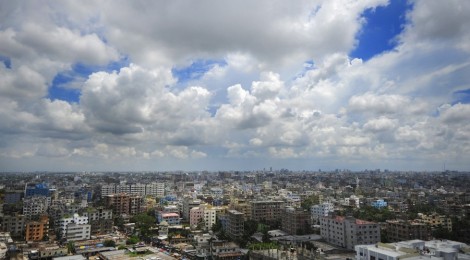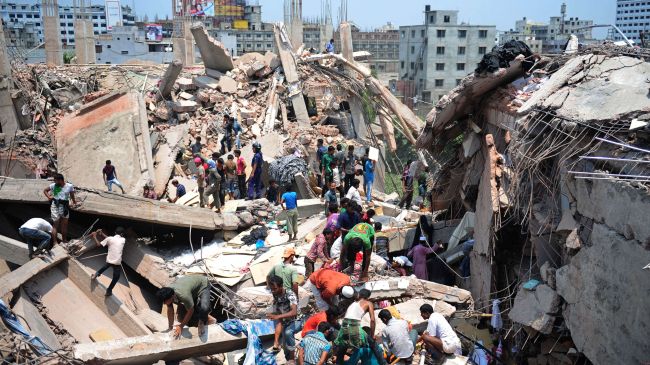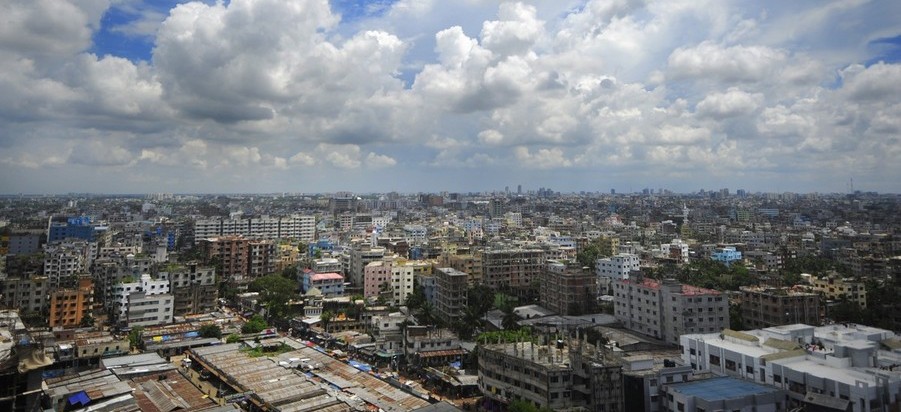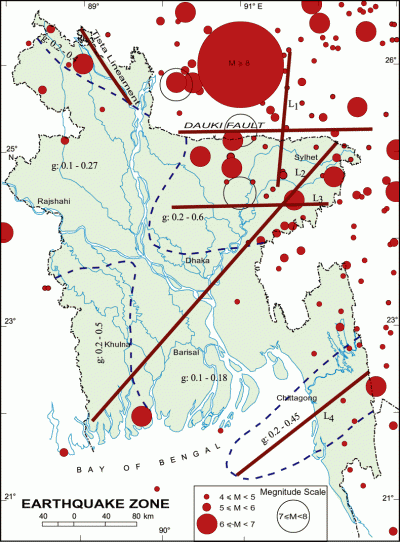
Collapsed factory is a sign of Bangladesh’s tremendous earthquake vulnerability
Buildings should not collapse spontaneously! On April 24th 2013, the eight-story Rana Plaza garment factory collapsed within the Greater Dhaka Area in Bangladesh, killing over 1,100 people and injuring another 2,500. This has brought a lot of attention to the working conditions of garment factory workers in Bangladesh and around the world, and the responsibility of retailers to promote safe working conditions in outsourced factories. Part of this story is also how factory managers allowed (in fact required!) workers to enter a building that had already shown signs of imminent collapse through significant cracking of the columns. This important story* also highlights the extreme vulnerability (built of concrete and steel), which people in Bangladesh live in every day.

Volunteers assist in the rescue operations after the collapse of the eight-story tall Rana Plaza in Dhaka, April 24, 2013. The collapse caused over 1,100 fatalities, mostly workers of a garment factory. (Credit PressTV)
Eight-story concrete frame buildings should not collapse spontaneously! This brings me dread when I think about the seismicity of Bangladesh. Had there been even a moderate earthquake on one of the many faults in proximity of Dhaka, the Rana Plaza would have without a doubt collapsed, along with thousands of other buildings. In fact a recent survey conducted by the Bangladesh University of Engineering and Technology found that three-fifth of garment factories are vulnerable to collapse. It is unclear what constitutes a threshold for “vulnerable” and what would trigger such collapse (presumably collapse could be spontaneous). But there is little reason to think that garment factories are uniquely vulnerable among buildings in Bangladesh. Residential and commercial buildings are probably no less vulnerable.

A general view of the Bangladeshi capital city Dhaka on September 20, 2010. The South Asian nation sits on active tectonic plates and is frequently jolted by tremors. The last major earthquake struck in 1896. (Credit AFP PHOTO/ Munir uz Zaman / Getty Images)
Bangladesh has a long history of earthquakes. In 1762, a major earthquake caused the submergence of 150 square kilometers of land, and killed 500 people in Dhaka, then only a small town. Between 1850 and 1950, there have been another 7 significant earthquake in the region, ranging in magnitude from 7.0 to 8.7 on the Richter scale.
Since the last significant earthquake, Bangladesh has changed quite significantly. The Greater Dhaka Area has a population of over 11 millions. A 2009 study conducted by the Government predicted over 120,000 casualties in Dhaka due to a 7.5M earthquake. Based on the HAZUS methodology, the risk analysis has significant uncertainty, and this number could easily be much, much larger.
Unfortunately, it usually takes an earthquake disaster to shift the politics of seismic risk, through the catastrophic demonstration of the extreme vulnerability of buildings. In Dhaka however, this demonstration has already occurred through the spontaneous collapse of a modern 8-storey building and the death of 1,100 people. Could this catalyze a shift in the politics of risk and promotion of earthquake resilience in Bangladesh?
————————————————————————-
I am not an expert on the earthquake risk in Bangladesh, nor about the resilience of Dhaka. But I would love to know more. In particular, I would be very interested to know more about the local projects, researchers and practitioners working to promote resilience of Bangladesh and its cities. Send us a comment or email!
*The story of the garment factory collapse is also one of disempowerment and abuse, in a world connected through the products we buy, but blind to the people behind them. I wanted here to highlight a simpler story about the earthquake vulnerability of Bangladesh, without going too deeply into the politics of poverty and power, while acknowledging that these are very much related to issues of vulnerability. For that I refer you to Professor Ananya Roy, a brilliant professor from UC Berkeley, who does extensive work on the politics of poverty and our relation to it.










The Bangladesh National Building Code (https://law.resource.org/pub/bd/bnbc.2006/) places Dhaka in a zone with moderate earthquake risk, with ground accelerations of 0.15g (10% chance of exceedance in 50 years). These accelerations are such that sensibly arranged well built buildings, even without particular special earthquake resistant design features, would suffer only moderate damage. Poorly built buildings will likely suffer significant damage though. For comparison, these ground accelerations are half those estimated for Port au Prince and a third of those for San Francisco, Wellington or much of Japan.
The OCHA assessment paints a very similar picture, with 20% chance of an earthquake intensity of VI of VII on the Mercalli scale being exceeded in a 50 year period. http://www.preventionweb.net/files/3759_ochabgdhazardv3110606.pdf The Mercalli scale measures the effects of the earthquake, not the energy or force: http://en.wikipedia.org/wiki/Mercalli_intensity_scale
The seismic hazard of Bangladesh appears to be based on very limited research however – it’s quite possible that the hazard is underestimated.
The seismic hazard in Dhaka is such that it is not unduly difficult or expensive to build buildings adequate to withstand the likely quakes – but it is quite possible that poorly built structures will suffer severe damage or collapse in the likely quake. It appears to be a serious problem, but not one that couldn’t be solved, if, as you say, the political will is there.
As a bit of background, the magnitude of the force on a building due to an earthquake depends on the following things:
– the quality of the soil it sits on. Poor soils will cause large amplification of the movements. Wet, silty soils are prone to liquefaction, which can cause catastrophic failure. Large parts of Dhaka are on poor soil, but only a small area (and any areas of reclaimed land) appears to be prone to liquefaction.
– the height of the building
– the weight of the building, and how it’s distributed up the building
– the ductility and damping of the building. Ductile buildings will dissipate energy, resulting in lower forces on the structure.
– the natural frequency of the building – buildings of 5-15 storeys are most likely to resonate with the earthquake, resulting in much larger forces.
– the arrangement of the building. symmetrical buildings behave well, asymmetrical buildings or irregularly shaped buildings tend to see force concentrations or torsional forces which can be extremely damaging.
Hi Tom! Thanks for the in-depth response and the additional references! Great information!
I agree with your statement that the “seismic hazard of Bangladesh appears to be based on very limited research.” Any seismic hazard map broken down into only three zones is questionable. Hopefully more data is being collected. I couldn’t find anywhere in the seismic zoning map the hazard level that it is referring to (10% in 50 years?). The response spectra in the code would suggest that it is actually 20% in 50 years.
Ultimately though, I am very skeptical about the performance of buildings even at 0.15g, let alone the 2% in 50 year hazard level, which is typically the benchmark used for “collapse prevention”. I think many buildings don’t meet the “sensibly arranged, well-built” criteria (hence collapsed factory)…
Hazard underestimated + vulnerability underestimated => very concerning situation